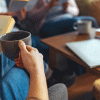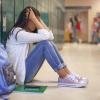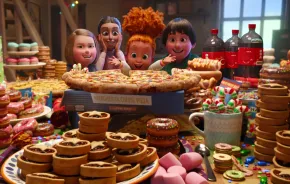
Parents are supposed to keep kids safe; our impulse is to protect our kids from worry about the big problems that threaten our world. But a great line in Sea of Monsters (the second book in Rick Riordan’s Percy Jackson series) sums up the problem with that instinct:
 "You fight the battles humanity must win, every generation, in order to stay human."
"You fight the battles humanity must win, every generation, in order to stay human."
We cannot give our children peace and equality; we can only teach our children how to work for them. And the sooner they start, the stronger they’ll be. The list of stories below on topics ranging from desegregation to the Holocaust to endangered species are by turns inspiring, heart-warming and entertaining but they have one message in common: You are never too young to stand up for what’s right.
Social-justice books for pre-K and early readers
- The Story of Ruby Bridges:
 Ruby BridgesMany books have been written about the courage of Ruby Bridges, the 6-year-old girl who desegregated Louisiana education under threat of violence. Robert Coles’ is geared toward kids the same age as Ruby during her year facing angry mobs. Through My Eyes is more advanced, but lets Ruby speak for herself.
Ruby BridgesMany books have been written about the courage of Ruby Bridges, the 6-year-old girl who desegregated Louisiana education under threat of violence. Robert Coles’ is geared toward kids the same age as Ruby during her year facing angry mobs. Through My Eyes is more advanced, but lets Ruby speak for herself.
- The First Step: This picture book by Susan E. Goodman is about the little girl who petitioned in 1847 to attend a white school, leading to desegregation of schools in the North and setting the legal precedent that the civil rights movement built on a century later.
- Baseball Saved Us: This picture book by Seattle-area author Ken Mochizuki presents the United States’ history of human rights abuse through a child’s eyes. It is based on a true story about Japanese internees who built a baseball diamond to help each other maintain hope and dignity during World War II.
 Ron's Big Mission: This picture book by Rose Blue and Corinne J. Naden tells the story of a real-life scientist who, as a little boy on a mission to check out aviation books, led to peaceful resistance that desegregated his local library.
Ron's Big Mission: This picture book by Rose Blue and Corinne J. Naden tells the story of a real-life scientist who, as a little boy on a mission to check out aviation books, led to peaceful resistance that desegregated his local library.
- The Curious Garden: A sweet and gentle picture book by Peter Brown about a boy who cares for a neglected garden and transforms his entire city into a better place.
Social-justice reads for middle grades
- Just a Drop of Water: Kerry O’Malley Cerra’s novel explores themes of loyalty, friendship, trust and revenge from the perspective of a 13-year-old boy whose friendship with a Muslim is challenged in the days after 9/11.
- Number the Stars: When Nazis take over Copenhagen and announce that the city’s Jews will be “relocated,” Annemarie and her parents risk their lives to help their Jewish friends escape to safety in this classic by Lois Lowry.
- Hoot:
 Carl Hiassen’s book about saving endangered owls is the first of several (unrelated) eco-mysteries he’s written and sets the tone for all – crude humor, cartoonish violence, plot holes you can drive a car through, and reckless adventures in pursuit of a good cause. Middle schoolers won’t even see the moral coming. The surprisingly nuanced message that methods matter even when you are right is summarized by the protagonist’s mom, “Honey, you didn’t break any laws. You didn’t hurt anybody. All you did was speak out for what you believed was right.” Hoot has been made into a movie, too.
Carl Hiassen’s book about saving endangered owls is the first of several (unrelated) eco-mysteries he’s written and sets the tone for all – crude humor, cartoonish violence, plot holes you can drive a car through, and reckless adventures in pursuit of a good cause. Middle schoolers won’t even see the moral coming. The surprisingly nuanced message that methods matter even when you are right is summarized by the protagonist’s mom, “Honey, you didn’t break any laws. You didn’t hurt anybody. All you did was speak out for what you believed was right.” Hoot has been made into a movie, too.
- This Journal Belongs to Ratchett: This homeschooled girl with the funny name helps her hippie father try to save a local park while she struggles to define herself. The journal format is more than just a conceit; doodles and margin notes surround the narrative, which is presented as handwritten journal entries and homeschool writing assignments.
- Operation Redwood: A young boy has to stand up to his own business-owning relatives to protect a grove of redwoods in this book for middle graders. Notable as a rare environmental story featuring a mixed-race protagonist, the story’s strength is in true-to-life moments of discovery and awe in nature that are much more effective than rhetoric.
Social-justice reads for teens
- The Chocolate War: Selling chocolate (or not) is hardly a social justice issue, but resisting the pressure to go along with the crowd is hard no matter what, and the courage to do so is a prerequisite for activism.
- The Adventures of Huckleberry Finn: Huckleberry Finn has always been controversial. It was criticized as “coarse” upon publication and has been condemned as racist ever since, and there is merit to both accusations. Despite racist language and stereotypes, the heart of Twain’s story is about trusting one’s instinct for kindness. Everything Huck has been taught tells him turning in a runaway slave is the right thing to do. But Huck helps Jim, trusting his heart over societal rules. Once considered a kids’ book, Huckleberry Finn is usually rated for young adults today, and definitely requires discussion to help young readers put the more appalling details into historical context.
- March: The three-part graphic novel by Congressman John Lewis is about his role as a young person in the civil rights movement. (The graphic novel format is not incidental; Lewis reveals in the book that he was motivated to civil action in part by a comic book.) Middle graders can easily read this book, but may not grasp its significance. Teens may be inspired to action.
- Little Brother: This dystopian YA thriller is the first in a series set in a near-future, near-realistic California that pits a teenage hacker against government abuses of the Patriot Act. It includes real-life technology tips for protecting online data and personal privacy.
Bonus: If you’re inspired to look for more books in this vein, the Jane Addams Children's Book Award recognizes quality children's books about social issues. You can search their database of award winners by topic.











